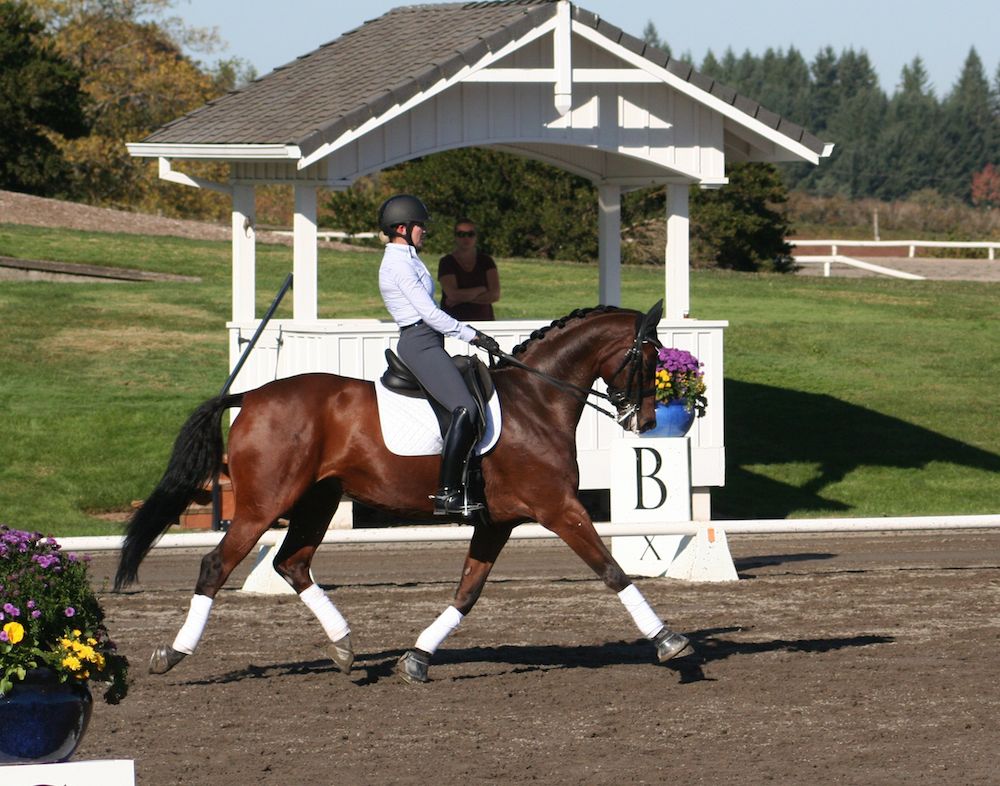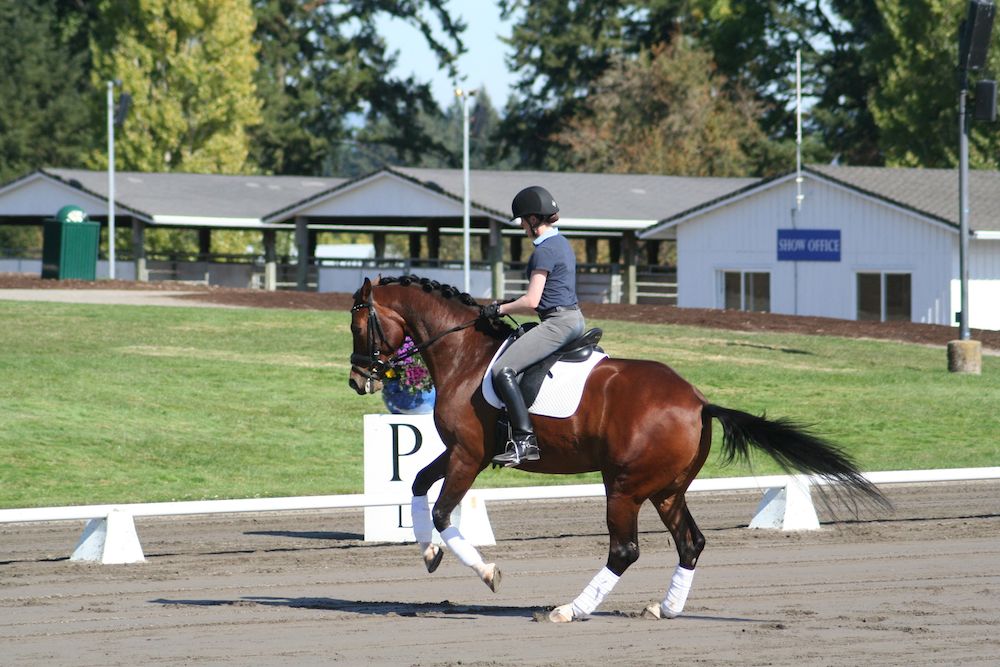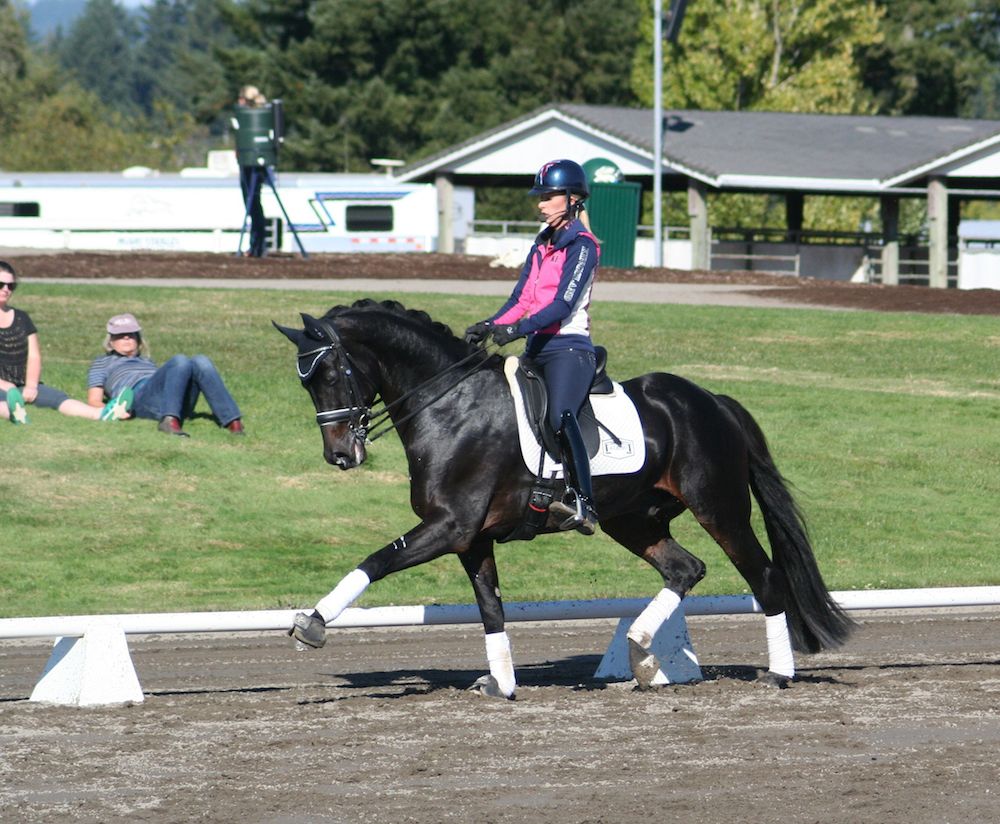“Competing is not why I do my sport,” Charlotte Dujardin told the crowd at Oregon’s Devonwood Equestrian Centre, “I do it for the training.”
The second day of Charlotte’s West Coast clinic dawned crisp and bright, and Charlotte delved deeper into the whys and hows of training and horse care.

Colleen Church McDowall was one of the riders taking advantage of the Charlotte Dujardin clinic, riding her Grand Prix mount Lord Albert. All Photos by Camilla Mortensen
All of Charlotte’s horses get turn-out, she said, from the youngest who are out 24/7, to top mount Valegro who goes out in the afternoons. “If you locked your child up all day and fed it, it’s going to be crazy,” she pointed out.
In addition to his four days a week being ridden by Charlotte and his workouts on a water-treadmill, Valegro is hacked out twice a week by an 80-year-old woman, Charlotte said. His schedule is designed to keep him “work fit and travel fit.” Valegro might be a champion dressage horse on his hacks “Blueberry,” as Valegro is called, happily eats his way around the farm. “We are not precious about who gets to ride our horses,” she said.
Blueberry got his barn name, she shared, because he came to his owner Carl Hester with a group of horses named after fruits and veggies like Radish and Tomato. In addition to her lively coaching, Charlotte also responded to questions from the auditors sassily facilitated by event organizer Scott Hayes, and talked a bit about her own history and Valegro’s future.
When Charlotte came to dressage she precociously taught her own Irish Thoroughbred piaffe after having learned the feeling of it riding a Grand Prix schoolmaster. She persuaded Carl Hester to take her on as student and was so excited when Hester rode her-then dressage mount Fernandez that she laughed, “I didn’t want to clean my saddle.”
ADVERTISEMENT
Working with Hester, Dujardin soon forged a bond with Valegro who Hester had once tried to sell as a jumper. She persuaded Hester to keep the horse and let her work with him. The partnership led to Valegro and Charlotte’s multiple world record scores, world championships and Olympic gold medals. At one point early on, another rider less than tactfully asked why Hester was allowing an amateur rider to show his horse. “Amateur doesn’t mean I can’t ride!” Charlotte said was her thought at the time, and she went on to beat the woman repeatedly at shows.
The story of Charlotte and Valegro that she shared has a fairy tale quality but Charlotte admitted that even she has her bad rides. Helping one of the day’s riders dealing with a mare who was shaking her head and kicking out at the feel of her rider’s legs, Charlotte observed, “This is what normal people go through.”
The mare, like the 4-year-old chestnut mare the previous day that spooked at the crackling microphone, soon settled into her work. “She’s young; she’s still learning; she’s a lady. She doesn’t want to be forced, she wants to be asked,” Charlotte said of the mare.
Charlotte spoke of prepping Valegro for the 2016 Olympic Games in Rio, saying the horse was prone to jet lag and the plan is so get him acclimated so he can adjust. And after the Olympics she said the goal is to retire Valegro, who will be 14, from competition and use him for demo rides, allowing him to have all the joy of dressage but not the pressure and allowing him to finish at the top of his game.
Valegro’s reward for a job well done is a sugar lump she said, and she tells him if he’s good at a show he can have the whole box. “He always gets the whole box,” she laughed.
The day’s horses ran the gamut from a 21-year-old pony to a charming draft/Thoroughbred to homebred and imported warmbloods, and with each Charlotte worked to improve their “push” or their “sit” or both. A top Grand Prix horse is good at both, she said.
Charlotte’s affection for each horse was clear. The draft cross, named Bear, or Teddy Bear as she called him, earned her particular affection. She had taught several of the horse/rider pairs earlier in the week at Grand Prix rider and trainer Alyssa Pitts’ Snohomish, Wash., barn, and said the first time she saw him Bear she thought, “Oh my God, his head’s so big! How can he carry that?” She added, “I love him.”
ADVERTISEMENT

Alyssa Pitts rode her Prix St. Georges horse, Quintessential Hit, in the clinic.
Though the clinic featured a different set of riders, including 14-year-old McKenzie Milburn on 21-year-old Westphalian pony Darius, the concepts continued from the day before: Building straight, supple horses that react to the leg and are responsive to the bit.
In addition to straightness, with many of the horses Charlotte worked with them on travers (haunches-in) and shoulder-fore. For the upper level horses, she uses an exercise that draws on both moves to develop the pirouette: Starting with a shoulder-fore, ride a half-pass to the centerline, then a few strides in shoulder-fore on the centerline followed by a half circle in the pirouette canter—with the haunches in and the shoulders turning—then half-pass back to the rail.
Toward the end of the day Charlotte got on Jennifer William’s talented Wrevolution. The horse is slightly hot, and Williams admitted she was more prone to the quieter types. “Ride hotter horses with your legs on,” Charlotte said, “lazy horses with your legs off.” Wrevolution, she said, “is the sort of horse I go for.” She laughed, “I’ll take this one home.”

Charlotte Dujardin ridng Wrevolution as she teaches.
Read all about Day 1 of the Charlotte Dujardin clinic at DevonWood.














